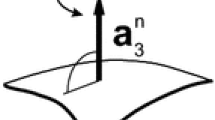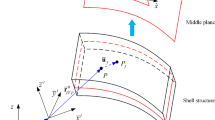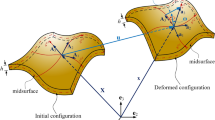Abstract
An edge-based smoothed finite element method (ES-FEM) combined with the mixed interpolation of tensorial components technique (MITC) for triangular elements, named as ES-MITC3, was recently proposed to enhance the accuracy of the original MITC3 for analysis of shells. In this study, the ES-MITC3 is extended to the geometrically nonlinear analysis of functionally graded shells. In the ES-MITC3, the stiffness matrices are obtained using the strain smoothing technique over the smoothing domains that formed by two adjacent MITC3 triangular shell elements sharing an edge. The material properties of functionally graded (FG) shells are assumed to vary through the thickness direction by a power rule distribution of volume fractions of the constituents. The nonlinear finite element formulation based on the first-order shear deformation theory with the von Kármán’s large deflection assumption is used to describe the large deformations of the FG shells. Several numerical examples are given to demonstrate the performance of the present approach in comparison with other existing methods.

















Similar content being viewed by others
References
Reddy J (2000) Analysis of functionally graded plates. Int J Numer Methods Eng 47:663–684
Praveen G, Reddy J (1998) Nonlinear transient thermoelastic analysis of functionally graded ceramic-metal plates. Int J Solids Struct 35:4457–4476
Ferreira A, Batra R, Roque C, Qian L, Martins P (2005) Static analysis of functionally graded plates using third-order shear deformation theory and a meshless method. Compos Struct 69:449–457
Mantari JL, Oktem AS, Soares CG (2012) Bending response of functionally graded plates by using a new higher order shear deformation theory. Compos Struct 94:714–723
Nguyen-Xuan H, Tran LV, Thai CH, Nguyen-Thoi T (2012) Analysis of functionally graded plates by an efficient finite element method with node-based strain smoothing. Thin Walled Struct 54(2012):1–18
Nguyen-Xuan H, Tran LV, Nguyen-Thoi T, Vu-Do HC (2011) Analysis of functionally graded plates using an edge-based smoothed finite element method. Compos Struct 93(2011):3019–3039
Tran LV, Thai CH, Nguyen-Xuan H (2013) An isogeometric finite element formulation for thermal buckling analysis of functionally graded plates. Finite Elem Anal Des 73:65–76
Tran LV, Phung-Van P, Lee J, Wahab MA, Nguyen-Xuan H (2016) Isogeometric analysis for nonlinear thermomechanical stability of functionally graded plates. Compos Struct 140:655–667
Phung-Van P, Nguyen-Thoi T, Luong-Van H, Lieu-Xuan Q (2014) Geometrically nonlinear analysis of functionally graded plates using a cell-based smoothed three-node plate element (CS-MIN3) based on the C0-HSDT. Comput Methods Appl Mech Eng 270:15–36
Arciniega RA, Reddy JN (2007) Large deformation analysis of functionally graded shells. Int J Solids Struct 44(2007):2036–2052
Tornabene F, Viola E (2009) Free vibrations of four-parameter functionally graded parabolic panels and shells of revolution. Eur J Mech A Solids 28:991–1013
Tornabene F, Viola E (2009) Free vibration analysis of functionally graded panels and shells of revolution. Meccanica 44:255–281
Shen H-S (2003) Postbuckling analysis of pressure-loaded functionally graded cylindrical shells in thermal environments. Eng Struct 25(2003):487–497
Shen H-S (2002) Postbuckling analysis of axially-loaded functionally graded cylindrical shells in thermal environments. Compos Sci Technol 62:977–987
Zhao X, Liew KM (2009) Geometrically nonlinear analysis of functionally graded shells. Int J Mech Sci 51:131–144
Sanders JL Jr (1963) Nonlinear theories for thin shells. Q Appl Math 21:21–36
Pradyumna S, Bandyopadhyay J (2008) Free vibration analysis of functionally graded curved panels using a higher-order finite element formulation. J Sound Vib 318:176–192
Sanders JL Jr (1959) An improved first-approximation theory for thin shells. NASA Tech. Report R-24, pp 1–11
Chau-Dinh T, Zi G, Lee P-S, Rabczuk T, Song J-H (2012) Phantom-node method for shell models with arbitrary cracks. Comput Struct 92:242–256
Vu-Bac N, Duong T, Lahmer T, Zhuang X, Sauer R, Park H et al (2018) A NURBS-based inverse analysis for reconstruction of nonlinear deformations of thin shell structures. Comput Methods Appl Mech Eng 331:427–455
Nguyen-Thanh N, Zhou K, Zhuang X, Areias P, Nguyen-Xuan H, Bazilevs Y et al (2017) Isogeometric analysis of large-deformation thin shells using RHT-splines for multiple-patch coupling. Comput Methods Appl Mech Eng 316:1157–1178
Areias P, Rabczuk T, Msekh M (2016) Phase-field analysis of finite-strain plates and shells including element subdivision. Comput Methods Appl Mech Eng 312:322–350
Areias P, Rabczuk T (2013) Finite strain fracture of plates and shells with configurational forces and edge rotations. Int J Numer Methods Eng 94:1099–1122
Rabczuk T, Gracie R, Song JH, Belytschko T (2010) Immersed particle method for fluid–structure interaction. Int J Numer Methods Eng 81:48–71
Rabczuk T, Areias P, Belytschko T (2007) A meshfree thin shell method for non-linear dynamic fracture. Int J Numer Methods Eng 72:524–548
Zienkiewicz O, Taylor R, Too J (1971) Reduced integration technique in general analysis of plates and shells. Int J Numer Methods Eng 3:275–290
Bletzinger K-U, Bischoff M, Ramm E (2000) A unified approach for shear-locking-free triangular and rectangular shell finite elements. Comput Struct 75:321–334
Tessler A, Hughes TJ (1985) A three-node Mindlin plate element with improved transverse shear. Comput Methods Appl Mech Eng 50:71–101
Nguyen-Xuan H, Rabczuk T, Bordas S, Debongnie J-F (2008) A smoothed finite element method for plate analysis. Comput Methods Appl Mech Eng 197:1184–1203
Nguyen-Xuan H, Nguyen-Thoi T (2009) A stabilized smoothed finite element method for free vibration analysis of Mindlin–Reissner plates. Commun Numer Methods Eng 25:882–906
Nguyen-Xuan H, Liu G, Thai-Hoang CA, Nguyen-Thoi T (2010) An edge-based smoothed finite element method (ES-FEM) with stabilized discrete shear gap technique for analysis of Reissner-Mindlin plates. Comput Methods Appl Mech Eng 199(2010):471–489
Nguyen-Xuan H, Rabczuk T, Nguyen-Thanh N, Nguyen-Thoi T, Bordas S (2010) A node-based smoothed finite element method with stabilized discrete shear gap technique for analysis of Reissner–Mindlin plates. Comput Mech 46:679–701
Nguyen-Thoi T, Liu G, Nguyen-Xuan H (2009) Additional properties of the node-based smoothed finite element method (NS-FEM) for solid mechanics problems. Int J Comput Methods 6:633–666
Nguyen-Thoi T, Phung-an P, Nguyen-Xuan H, Thai-Hoang C (2012) A cell-based smoothed discrete shear gap method using triangular elements for static and free vibration analyses of Reissner–Mindlin plates. Int J Numer Methods Eng 91:705–741
Nguyen-Thoi T, Phung-Van P, Thai-Hoang C, Nguyen-Xuan H (2013) A cell-based smoothed discrete shear gap method (CS-DSG3) using triangular elements for static and free vibration analyses of shell structures. Int J Mech Sci 74:32–45
Nguyen-Thoi T, Phung-Van P, Luong-Van H, Nguyen-Van H, Nguyen-Xuan H (2013) A cell-based smoothed three-node Mindlin plate element (CS-MIN3) for static and free vibration analyses of plates. Comput Mech 51:65–81
Bathe KJ, Dvorkin EN (1985) A four-node plate bending element based on Mindlin/Reissner plate theory and a mixed interpolation. Int J Numer Methods Eng 21:367–383
Lee P-S, Bathe K-J (2004) Development of MITC isotropic triangular shell finite elements. Comput Struct 82:945–962
Lee Y, Lee P-S, Bathe K-J (2014) The MITC3+ shell element and its performance. Comput Struct 138:12–23
Lee Y, Yoon K, Lee P-S (2012) Improving the MITC3 shell finite element by using the Hellinger–Reissner principle. Comput Struct 110:93–106
Ko Y, Lee P-S, Bathe K-J (2016) The MITC4+ shell element and its performance. Comput Struct 169:57–68
Bathe K-J, Lee P-S, Hiller J-F (2003) Towards improving the MITC9 shell element. Comput Struct 81:477–489
da Veiga LB, Chapelle D, Suarez IP (2007) Towards improving the MITC6 triangular shell element. Comput Struct 85:1589–1610
Ko Y, Lee Y, Lee P-S, Bathe K-J (2017) Performance of the MITC3+ and MITC4+ shell elements in widely-used benchmark problems. Comput Struct 193:187–206
Jun H, Yoon K, Lee P-S, Bathe K-J (2018) The MITC3+ shell element enriched in membrane displacements by interpolation covers. Comput Methods Appl Mech Eng 337:458–480
Nguyen-Xuan H, Liu G, Nguyen-Thoi T, Nguyen-Tran C (2009) An edge-based smoothed finite element method for analysis of two-dimensional piezoelectric structures. Smart Mater Struct 18:065015
Nguyen-Xuan H, Tran LV, Nguyen-Thoi T, Vu-Do H (2011) Analysis of functionally graded plates using an edge-based smoothed finite element method. Compos Struct 93:3019–3039
Phan-Dao H, Nguyen-Xuan H, Thai-Hoang C, Nguyen-Thoi T, Rabczuk T (2013) An edge-based smoothed finite element method for analysis of laminated composite plates. Int J Comput Methods 10:1340005
Phung-Van P, Thai CH, Nguyen-Thoi T, Nguyen-Xuan H (2014) Static and free vibration analyses of composite and sandwich plates by an edge-based smoothed discrete shear gap method (ES-DSG3) using triangular elements based on layerwise theory. Compos B Eng 60:227–238
Nguyen-Thoi T, Bui-Xuan T, Phung-Van P, Nguyen-Hoang S, Nguyen-Xuan H (2014) An edge-based smoothed three-node Mindlin plate element (ES-MIN3) for static and free vibration analyses of plates. KSCE J Civ Eng 18:1072–1082
Chau-Dinh T, Nguyen-Duy Q, Nguyen-Xuan H (2017) Improvement on MITC3 plate finite element using edge-based strain smoothing enhancement for plate analysis. Acta Mech 228:2141–2163
Nguyen T-K, Nguyen V-H, Chau-Dinh T, Vo TP, Nguyen-Xuan H (2016) Static and vibration analysis of isotropic and functionally graded sandwich plates using an edge-based MITC3 finite elements. Compos B Eng 107:162–173
Pham Q-H, Tran T-V, Pham T-D, Phan D-H (2017) An edge-based smoothed MITC3 (ES-MITC3) shell finite element in laminated composite shell structures analysis. Int J Comput Methods 15:1850060
Pham-Tien D, Pham-Quoc H, Vu-Khac T, Nguyen-Van N (2017) Transient analysis of laminated composite shells using an edge-based smoothed finite element method. In: International conference on advances in computational mechanics, 2017, pp 1075–1094
Crisfield MA (1993) Non-linear finite element analysis of solids and structures, vol 1. Wiley, New York
Reddy JN (2004) Mechanics of laminated composite plates and shells: theory and analysis. CRC Press, Boca Raton
Zhao X, Liew KM (2009) Geometrically nonlinear analysis of functionally graded plates using the element-free kp-Ritz method. Comput Methods Appl Mech Eng 198:2796–2811
Cui X, Liu G-R, Li G-Y, Zhang G, Zheng G (2010) Analysis of plates and shells using an edge-based smoothed finite element method. Comput Mech 45:141
Nguyen-Hoang S, Phung-Van P, Natarajan S, Kim H-G (2016) A combined scheme of edge-based and node-based smoothed finite element methods for Reissner–Mindlin flat shells. Eng Comput 32:267–284
Zienkiewicz OC, Taylor RL, Taylor RL (2000) The finite element method: solid mechanics, vol 2. Butterworth-Heinemann, Oxford
Liu G, Nguyen-Thoi T, Lam K (2009) An edge-based smoothed finite element method (ES-FEM) for static, free and forced vibration analyses of solids. J Sound Vib 320:1100–1130
Urthaler Y, Reddy J (2008) A mixed finite element for the nonlinear bending analysis of laminated composite plates based on FSDT. Mech Adv Mater Struct 15:335–354
Pica A, Wood R, Hinton E (1980) Finite element analysis of geometrically nonlinear plate behaviour using a Mindlin formulation. Comput Struct 11:203–215
Sze K, Liu X, Lo S (2004) Popular benchmark problems for geometric nonlinear analysis of shells. Finite Elem Anal Des 40:1551–1569
Arciniega R, Reddy J (2007) Tensor-based finite element formulation for geometrically nonlinear analysis of shell structures. Comput Methods Appl Mech Eng 196:1048–1073
Author information
Authors and Affiliations
Corresponding author
Additional information
Publisher’s note
Springer Nature remains neutral with regard to jurisdictional claims in published maps and institutional affiliations.
Rights and permissions
About this article
Cite this article
Pham, QH., Pham, TD., Trinh, Q.V. et al. Geometrically nonlinear analysis of functionally graded shells using an edge-based smoothed MITC3 (ES-MITC3) finite elements. Engineering with Computers 36, 1069–1082 (2020). https://doi.org/10.1007/s00366-019-00750-z
Received:
Accepted:
Published:
Issue Date:
DOI: https://doi.org/10.1007/s00366-019-00750-z




